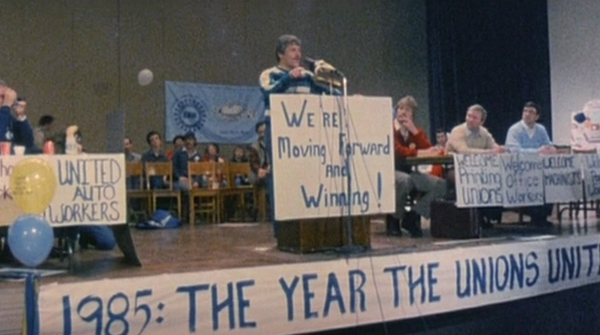American Dream Review
Posted on August 4, 2018 By John Gilpatrick 1990s, Classic Reviews, Documentaries, Movie Reviews
About a decade and a half after producing and directing one of the most powerful and influential documentaries of all time, Barbara Kopple returned to the world of workers’ rights for American Dream. It’s an interesting title that immediately tells the viewer that this film won’t be as tied down to a specific place as its predecessor.
This point is reiterated almost immediately after the film begins. Following a brief montage of news clips featuring anchors telling us about the dire state of the meatpacking industry circa 1986, we’re taken to a Jesse Jackson-led rally in Austin, Minnesota – our home base for the bulk of the film. His first words, “This isn’t just about Austin, Minnesota.”
It’s also packed to the brim with symbolism. American Dream opens with pigs being slaughtered and packed into neat styrofoam and cellophane containers for public consumption. Before even giving us an opening title shot, we’re visually told that the people doing the packing are in fact the pigs. Let’s watch how they get “slaughtered” every day. Like these opening shots, it’s not pretty.
Eventually, the film lets us in on the complicated mechanics of this particular strike. The local P-9 union is demanding a contract that guarantees $10.69 per hour for its employees at Hormel. Unlike Harlan County’s strike a decade earlier, this one is defined by its shades of gray. By and large, it’s not a story of heroes vs. villains; instead, you have multiple sides acting in what they think is their best interest. Unfortunately, those interests don’t often align.
The local union takes a hard-line stance in their demands for this new salary floor. They go about it by demanding a re-examination of their entire contract, which apparently does major damage to years of progress made by the national union, which doesn’t support the actions of the local workers (for this and other reasons). The local then hires a freelance negotiator who later appears to be in way over his head. Meanwhile, the company itself is completely uninterested in the politics of organized labor, so they just lock out the workers and bring in replacements. Paychecks disappear, as do houses, cars, livelihoods.
Like in Harlan County U.S.A., this involves a giant white-collar wall that blue-collar workers struggle to climb over. The difference with this particular story is that as the blue-collar workers argue over whether they use a rope or a ladder, the wall keeps getting bigger. (This film depicted events of the mid- to late-eighties. Is it any wonder, all these years later, that workers like these have flocked to a strongman promising to restore the days of blue-collar manufacturing glory? And the better question: Is this life what said strongman is talking about?)
American Dream’s more pointed focus on politics means it lacks some of the cultural touches, like its music, that make Harlan County U.S.A. such a verite milestone. Perhaps that’s why it’s less remembered than its predecessor. However, I keep coming back to the title of the film because, generally speaking, I think it says so much about a filmmaker’s window onto the story he or she is trying to tell. As good as this film is – and it’s great – no amount of acclaim can guarantee a film’s place in an enduring cultural discussion. It needs to present ideas in a truly novel and forward-thinking fashion or in a way in which its emotions overwhelm the viewer without becoming saccharine or false.
Harlan County U.S.A. achieves both of these points. American Dream almost gets there with the latter. If this is Kopple’s view of the actual “American dream” in the early 1990s, it’s grim. In fact, the dream is already lost – gone by the way of art deco and 8-tracks. All that’s left is the styrofoam and cellophane.
1990, American Dream, Barbara Kopple, Documentaries, Harlan County U.S.A.














